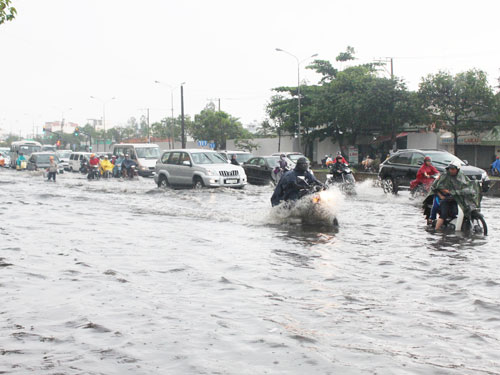VietNamNet Bridge – Mekong Delta and HCM City would suffer most if the sea
water rises by two meters. If so, the delta would be nearly eliminated with 92
percent of area to be inundated.

According to MONRE Minister Nguyen Minh Quang, the latest scenario has been
updated on the basis of the 2009’s version, which was drawn up by recapitulating
the domestic and international research works. Besides, the ministry also
considered the monitoring reports from 200 meteorological stations, 17
oceanographic stations, and analyzing the monitoring data from satellites and
other sources.
The latest scenario shows a worse situation than the 2009’s scenario. The
average annual temperature increase in the north of the central region could be
3.5 oC, while it was 2.8 oC in the 2009’s scenario. The rainfall in the dry
season may drop by up to 30 percent, while the 2009’s scenario said the rainfall
would decrease by 18 percent only.
MONRE’s scientists have calculated that by 2100, the average temperature would
increase by 2-3 oC, while the temperature would increase more sharply of 3.1-3.4
oC in the central provinces from Ha Tinh to Quang Tri. The country would
experience the number of hot days increasing by 10-20 a year (more than 35oC).
The rainfall would increase by 2-7 percent per annum, but would increase by less
than 3 percent in the Central Highlands and the south of central region.
The worrying thing is that the rainfall tends to decrease in the dry season and
increase in the rainy season. Especially, anomalous may appear in different
areas with the rainfall double the current level. While the pressure would
increase in the mainland and the Eastern Sea, the humidity would decrease,
especially in the east of the northern and southern region.
HCM City suburbs would be heavily inundated
Scientists have pointed out that the climate change would happen in three
levels, low, medium and high, depending on the greenhouse gas emission level and
the socio-economic development.
With the medium scenario, if the sea water level rises by one meter, 2.5 percent
of the coastal areas in the central region, 10 percent of the Red River Delta,
20 percent of HCM City and 39 percent of Mekong River Delta area would be
inundated.
This would influence 7 percent of population in the coastal areas, 9 percent, 9
percent and 35 percent of population in other areas, respectively.
The sea water rise would badly affect 4 percent of the railway system, 9 percent
of the highway and 12 percent of provincial roads. The provinces in Mekong
Delta, including Ca Mau, Bac Lieu, Kien Giang and Hau Giang may see most of the
area inundated.
In HCM City, heavy flood would occur in the districts of 2, 9, Binh Tan, Can Gio,
Binh Chanh, Hoc Mon and Cu Chi.
In case the emission level in the world and in Vietnam is overly high, the
climate change would bring worse impacts with the sea water rise of up to 2
meters. If so, the Mekong River Delta would be nearly eliminated with 92 percent
of total area under water.
Meanwhile, the two key economic development points in Red River Delta and HCM
City would also be heavily flooded with 30-36 percent of area under the water.
Source: NLD
- © Copyright of Vietnamnet Global.
- Tel: 024 3772 7988 Fax: (024) 37722734
- Email: evnn@vietnamnet.vn